World Dream Bank
home -
add a dream -
newest -
art gallery -
sampler -
dreams by
title,
subject,
author,
date,
places,
names
Abyssia:
Sandwichia
and the Orcadian Isles
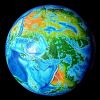
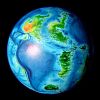
by Chris Wayan, 2004
for Ernest Shackleton of South Georgia fame
plus of course the Earl of Sandwich
Abyssia home - down to
map -
building Abyssia -
geology & geography -
critters & cultures -
the clash of names -
more worlds? Planetocopia!
Introduction
-
the Arc -
Orcadian Is. -
Creatures & Cultures
Sandwichia is a curving, savagely mountainous island northwest of Weddellia in Abyssia's equivalent of our South Atlantic. It's an island arc on its own tectonic platelet, that may be forming its own continent--slowly fusing together the Orcadian Islands and the shallow banks between them with alluvial sediment and volcanic ash. It's certainly trying hard.

This is an island arc on Earth, too, of course--the South Sandwich Islands off Tierra del Fuego, where part of a plate boundary got stuck, creating the chaos of the Scott Basin in its wake. What's amusing is how little changed this region is, upside down! Island arc becomes trench, trench becomes mountainous island. Shackleton's jagged South Georgia disappears, but Sandwichia rises, and subduction continues--only now the Scotia Basin platelet slides under the Atlantic plate...
Here's an orbital photo taken in June; early winter snows blanket the heights. The much smaller white areas on the map are year-round: glaciers.
Introduction -
The Arc
-
Orcadian Is. -
Creatures & Cultures
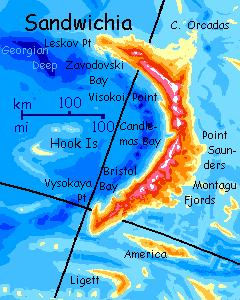
The Meteor Mountains rise up to 3600 m (nearly 12,000'). That's the highest range in 10,000 km (6000 mi)--basically, the whole hemisphere. Abyssia as a whole has low topography; Sandwichia is a glorious exception. Rugged and very scenic. The Meteors are studded with volcanoes, many of them dormant and iced over, but some live; this is a plate-boundary island arc, a displaced bit of our Ring of Fire. And danger: not just from the mudflows and rare explosions from the live cones, but from even deadlier avalanches and steam explosions from the dormant, ice-plugged ones. A chaotic splendor!
Climate? New Zealand or northern Japan, I'm not sure. Take your pick. Sandwichia is closer to the pole, but Abyssia's poles are milder than Earth's: no icecaps. Except right here, I mean--the glaciers capping the stratovolcanoes of the Meteor Range are the biggest in the whole Antarctic!
All in all, a spectacular place to visit, and (in the valleys, and out on Cape Orcadas) a fertile one, but in general, an unsettled and unsettling place to live. A continent under construction.
Perpetual construction.
Involving demolition.
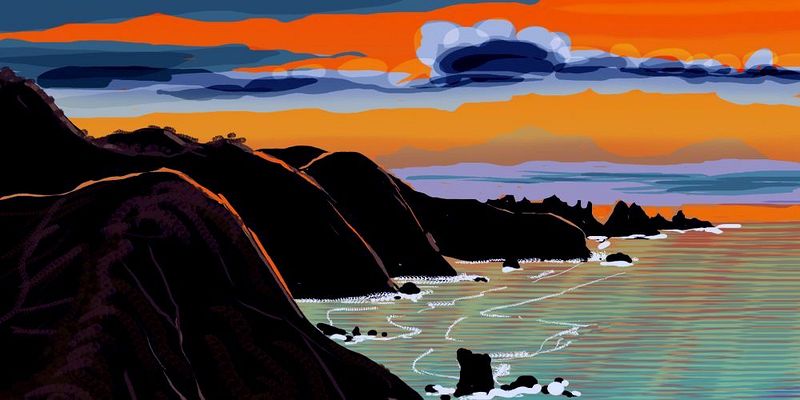
Sunset, Sandwichia; faux print by Wayan, based on detail of a Tom Killion woodcut, "Muir Beach"
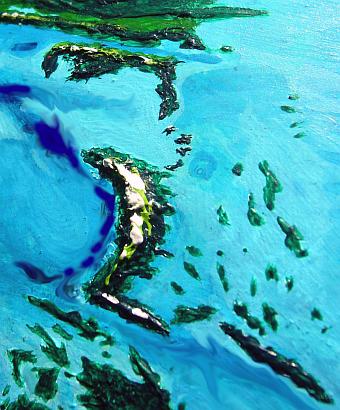
Introduction -
the Arc -
The Orcadian Isles
-
Creatures & Cultures
These islands east of Sandwichia are less impressively vertical but are more fertile (no ice!). Around them are wide shallow banks--and these banks have a future.
For unlike the islands of our South Atlantic, which rise from deep sea, the Orcadians are just the high points of an extensive rise. The New Zealand analogy continues to be good! Zealand is just the visible tip of a near-continental platform largely flooded by our interglacial sea-level rise; Orcadia's rise is smaller, but still larger than New Guinea--perhaps half the size of Greenland.
And iceless Abyssia has stable sea levels; as the busy mountains of Sandwichia go on building, eroding and rebuilding, a long slope like America's prairies should accumulate over the next few million years. Unlike, say, our Mississippi Delta, building itself slowly into waters two miles deep in the Gulf of Mexico, Sandwichia's rivers (and more to the point, volcanoes) have a much easier task; most of the Orcadian Rise is less than 200 meters deep.
So Greater Orcadia is quite likely! My best guess is, this mini-continent will look much like Argentia just to the northwest--similar size, at least. Just more scenic. Sandiwichia's volcanoes aren't bulldozers! Once the continental contract's fulfilled, no one's driving them off to the next job. The Meteor Range will go right on remodeling. Like that contractor you know who can never finish his own house. There's always another project!
Too bad it involves demolition.
Introduction -
the Arc -
Orcadian Is. -
Creatures and Cultures
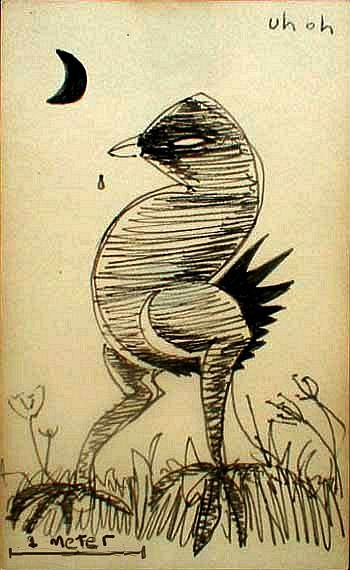
Sandwichia is cool. I mean, yes, scenically too, but climatically. The cold has shaped native life. On Abyssia's islands and smaller continents, the dominant life form is often a large flightless bird, but Sandwichia's climate favors very large creatures--they retain heat better. And it's a big, varied island; on islets with a single habitat, drought or fire or flood or population booms and busts of prey species can let giants starve; the result is island dwarfism. Not here! Sandwichia has a couple of giants, in fact; one native, one not.
The Uh-Oh Bird is native. Gigantic, big-headed, beaky hunters rather like our Brontornis, left (sketch by Stanton Fink). My cartoon of the Uh-Oh, right, isn't serious--it's a scaled-up terrorizing Tweety Bird. Except for the scale--the Uh-Oh often really does pass three meters tall--10'! A wandering solitary carnivore, like the Siberian tiger or polar bear, this bird has a relentless appetite and a hot temper. Wolves and lions learn to cooperate; but for these predators, teamwork (and friends) just aren't on the agenda.
Ironically, this very ferocity stunted their evolution in another direction. On other islands, smaller flightless birds had to cooperate; social pressures fostered intelligence; and the forehands that all Abyssian vertebrates possess make tool-use easier than on four-limbed Earth. But the Uh-Oh reigned as a pure, solitary predator, not really needing tools or hunting partners. Over several million years, as other avians climbed to civilization, the Uh-Oh stayed stable as a shark.
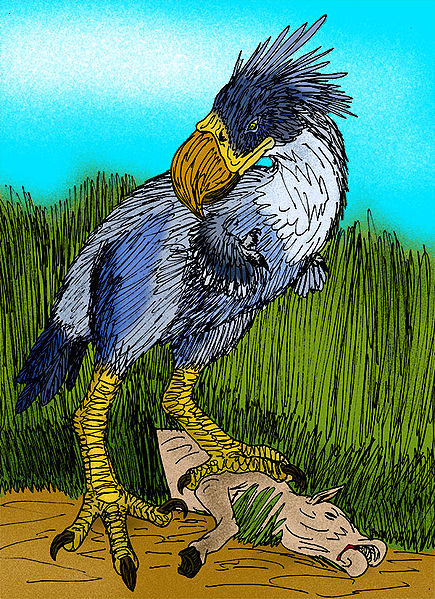
Further, its fighting temperament and near-total carnivorism pushed Uh-Ohs away from the modest size and hollow bones of their flying ancestors, presumably stranded in some storm. Today the Uh-Oh has solid, heavy bones that support its massive body in the roughest fight--but that body is distinctly heavier than water. The Uh-Oh is trapped on Sandwichia--they can't swim even the narrow straits to Falkland and Argentia. It's not a matter of learning or practice; they just sink.
Brontornis, named after the extinct big-beaked hunter of ancient Argentina, is not native, but dominates the island. An immigrant from Falkland and Argentia to the north, this species is an omnivore leaning carnivorous. Fierce too, but the Brontornis did learn to cooperate--and rose to intelligence. Its temperament is also feisty, but capable of restraint. Had to be--once edged weapons develop, compulsive quarrelers don't last long.
What other Abyssians notice about the Sandwichian bronts isn't their temper--they're no fiercer than their ancestors back in Argentia--but their size. The cooler climate favors giants, and the Sandwichians are about as big as intelligent birds get, anywhere on Abyssia. Nearly as big as the Uh-Oh. Even by Terran standards, a creature standing 2.5m tall (8') and weighing a couple of hundred kilos is big, but for Abyssia that's HUGE--there isn't a land animal of any kind over a ton, and a bare handful even close to a bront.
So when a bront squad of rangers spear-hunts a rogue Uh-Oh that's been foolish enough to poach their livestock or attack a solo traveler, there's little doubt who's going to end up dead.
It's not like Ice Age hunters attacking mammoths a hundred times their weight--that took unbelievable courage. Also brutality. A horror story when you realize the mammoths were probably as intelligent as the hunters. People hunting and eating another species of... people.
No such sort-of-cannibals here. Nor heroes, really.
Just pest control.
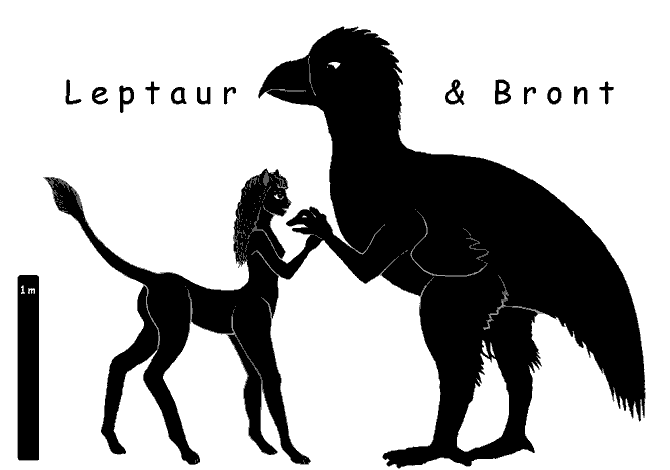
The Orcadian Isles, lower, ice-free, warmer than Sandwichia, have a very different population mix. The vast majority on most islands are leptaurs, those intelligent, omnivorous, feline centauroids native to Atlantis and common throughout this hemisphere. They're barely hip-high next to bronts, standing less than 1.5 m (5') tall and not much heavier than the average human.
The leptaurs aren't alone. There are bronts here. Their ancestors sailed here (horribly seasick the whole way) not on their own but in boats owned and operated by leptaur co-ops. Their descendants have stayed put on solid ground--families tend to remember grandparental horror stories about the frightful passage.
The two species get along quite well despite their very different sizes and temperaments. They find each other somewhat comical, but useful and reliable--complementary in strength, dexterity, lifting ability, climbing ability... Mixed communities have economic and social advantages.
Uh-ohs? Oh, they never made it here at all; and why would anyone import a nuisance? Yes, on Earth today they'd be a tourist attraction and a sort of mascot for the whole country; but not on Abyssia, at least not on these quiet farm isles.
Remember how white settlers treated the Tasmanians! Human and thylacine.
 TOURS: this route snakes around Abyssia's major lands -
Lena Is. (brr!) -
Greek Is. -
Atlantis -
Azorea -
Cayman and Albatrosia -
Andean Is. -
Scotia Is. -
Morningtonia -
Agassiz -
South Pacifica -
East Pacifica -
Hawaiian Sea -
Pacifica Desert -
Filipinia -
Banda Is. -
Vityaz Archipelago -
Tasman Is. -
The Bight -
Whartonia -
Chagosia -
Somalia -
Mascarenia and Crozetia -
Weddellia -
Argentia -
Pernambuco -
Angolia -
Tristania -
Agulhas group
TOURS: this route snakes around Abyssia's major lands -
Lena Is. (brr!) -
Greek Is. -
Atlantis -
Azorea -
Cayman and Albatrosia -
Andean Is. -
Scotia Is. -
Morningtonia -
Agassiz -
South Pacifica -
East Pacifica -
Hawaiian Sea -
Pacifica Desert -
Filipinia -
Banda Is. -
Vityaz Archipelago -
Tasman Is. -
The Bight -
Whartonia -
Chagosia -
Somalia -
Mascarenia and Crozetia -
Weddellia -
Argentia -
Pernambuco -
Angolia -
Tristania -
Agulhas group
Abyssia's homepage - map - peoples - regional tours - names
LISTS AND LINKS: More worlds? Planetocopia! - dreams of other worlds - ecology - climate change - evolution - natural disasters - terraforming - sculptures and 3D art -
World Dream Bank homepage - Art gallery - New stuff - Introductory sampler, best dreams, best art - On dreamwork - Books
Indexes: Subject - Author - Date - Names - Places - Art media/styles
Titles: A - B - C - D - E - F - G - H - IJ - KL - M - NO - PQ - R - Sa-Sk - Sl-Sz - T - UV - WXYZ
Email: wdreamb@yahoo.com - Catalog of art, books, CDs - Behind the Curtain: FAQs, bio, site map - Kindred sites